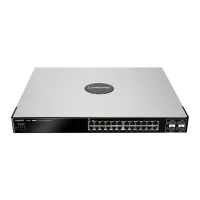Configuring SNMP
Defining Trap Management
Cisco Small Business SFE/SGE Managed Switches Administration Guide 326
12
-
Inform
— Indicates informs are sent.
Either SNMPv1,2 or SNMPv3 may be used as the version of traps, with only one
version enabled at a single time. The SNMPv1,2 Notification Recipient area
contains the following fields:
• SNMPv1,2 — Enables SNMPv1,2 as the Notification version. If SNMPv1,2 is
enabled, the Community String and Notification Version fields are enabled for
configuration:
• Community String — (SNMP v1, 2) Identifies the community string of the trap
manager.
• Notification Version — (SNMP v1, 2) Determines the trap type. The possible
field values are:
-
SNMP V1
— Indicates SNMP Version 1 traps are sent.
-
SNMP V2
— Indicates SNMP Version 2 traps are sent.
The SNMPv3 Notification Recipient area contains the following fields:
• SNMPv3 — Enables SNMPv3 as the Notification version. If SNMPv3is enabled,
the User Name and Security Level fields are enabled for configuration:
• User Name — Defines the user to whom SNMP notifications are sent.
• Security Level — (SNMP v3) Defines the means by which the packet is
authenticated. The possible field values are:
-
No Authentication
— Indicates the packet is neither authenticated nor
encrypted.
-
Authentication
— Indicates the packet is authenticated.
-
Privacy
— Indicates the packet is both authenticated and encrypted.
The UDP Port Notification Recipient area contains the following fields:
• UDP Port — Displays the UDP port used to send notifications. The default is
162.
• Filter Name — Indicates if the SNMP filter for which the SNMP Notification filter
is defined.
• Informs Timeout — Indicates the amount of time (seconds) the device waits
before re-sending informs. The default is 15 seconds.
• Informs Retries — Indicates the amount of times the device re-sends an inform
request. The default is 3 seconds.

